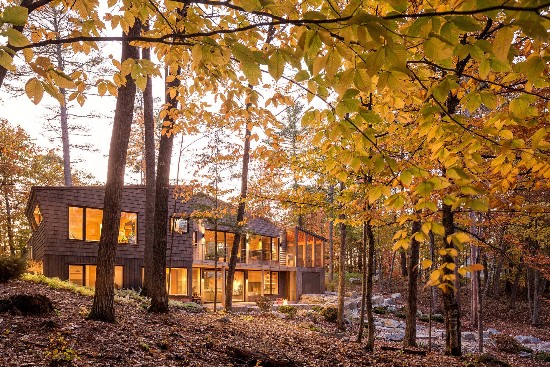Bloomberg Green sent out an email blast describing the work of a Maine home builder, Jesper Kruse, who developed a housing concept twelve years ago to address energy efficiency and environmental concerns. Demand for what he called passive homes has risen as governments and individuals look to how they can contribute to reducing carbon emissions and fight global warming.
In the U.S. today, the contribution of greenhouse gasses (GHG) coming from buildings represents 13% of the country’s total emissions. I will let Todd Woody, the author of this piece tell the rest of the story.
Passive building involves a set of design principles and a certification standard for structures that achieve extreme energy efficiency through construction techniques that seal them in an airtight envelope, reducing energy consumption for heating and cooling by as much as 75%.
“We have probably gotten 10 times the amount of inquiries in the last couple of years than we’ve received before,” says Kruse, owner of Maine Passive House.
Kruse, who was among the first group of builders to be certified, attributes the boom partly to an influx of new residents to Maine seeking refuge from the Covid‑19 pandemic. But he says demand also is largely growing due to widening awareness of the need for resilient homes amid a changing climate. The increasing frequency of heatwaves, hurricanes, wildfires, and power outages, as well as rising energy prices, has put a premium on buildings that minimize energy consumption and maintain a constant temperature.
“The house won’t freeze if you lose power in the winter,” Kruse says, “which is a frequent occurrence in rural Maine.”
Katrin Klingenberg is executive director and co-founder of Passive House Institute US, a nonprofit that trains passive home builders and certifies buildings. She says that from 2011 to 2021, 16 million square feet of construction— single-family homes, apartment complexes and commercial structures—was submitted for certification. The institute projects builders will seek approval of an additional 11 million square feet in 2022.
“We’re seeing exponential, hockey-stick growth,” Klingenberg says. “Any certified builder or designer with experience is in high demand and perfectly positioned in the market right now.”
Before construction begins, Kruse uses a software program to design a home and model its energy consumption based on a variety of factors, including the location of the building and the impact of insulation and airtight triple-pane windows and doors.
“It gets nerdy pretty quick,” says Kruse. “Rather than just building the building, you’re actually putting in a whole lot of information and then you’re evaluating how the house is going to perform before starting construction.”
The key indicator is air-tightness. In a passive home the slab, walls, and roof are thickly insulated, and the shell is constructed to eliminate any pathways for air to escape. That requires a detailed plan to construct the home in a precise sequence so all the building materials fit together in a way that seals the structure. A ventilation system circulates fresh air, and the home is positioned on its site to maximize the heat it absorbs from the sun in the winter while staying cool in the summer.
The low energy demands mean builders can forgo a fossil fuel furnace. Kruse says he usually installs highly efficient air-source heat pumps, electrical devices that extract warmth from the outside atmosphere and circulate the heated air throughout the house. In the summer, heat pumps cool a home by transferring hot air from inside the house to the outside.
Passive single-family homes often cost about 10% more than conventional ones, but multifamily buildings are on par because of apartments’ shared walls and floors. Klingenberg says that state incentives that subsidize the training of passive house builders and qualify the buildings for tax breaks are lowering construction costs and spurring demand.
She says that while passive houses have been most popular in cold regions like the Northeast, climate change is sparking interest in the West as residents face increasingly intense and frequent heatwaves and wildfires. The construction techniques that keep passive houses warm in winter also keep them cool in summer while sealing them off from wildfire smoke and filtering out pollutants and pathogens.
For Kruse, the durability, comfort, and health aspects have become big selling points.
“We have clients who want to save the world,” he says. “But there are also people out there who just want a well-built and resilient home.”
















